A Current Review of the Meniscus Imaging: Proposition of a Useful Tool for Its Radiologic Analysis
- PMID: 27057352
- PMCID: PMC4766355
- DOI: 10.1155/2016/8329296
A Current Review of the Meniscus Imaging: Proposition of a Useful Tool for Its Radiologic Analysis
Abstract
The main objective of this review was to present a synthesis of the current literature in order to provide a useful tool to clinician in radiologic analysis of the meniscus. All anatomical descriptions were clearly illustrated by MRI, arthroscopy, and/or drawings. The value of standard radiography is extremely limited for the assessment of meniscal injuries but may be indicated to obtain a differential diagnosis such as osteoarthritis. Ultrasound is rarely used as a diagnostic tool for meniscal pathologies and its accuracy is operator-dependent. CT arthrography with multiplanar reconstructions can detect meniscus tears that are not visible on MRI. This technique is also useful in case of MRI contraindications, in postoperative assessment of meniscal sutures and the condition of cartilage covering the articular surfaces. MRI is the most accurate and less invasive method for diagnosing meniscal lesions. MRI allows confirming and characterizing the meniscal lesion, the type, the extension, its association with a cyst, the meniscal extrusion, and assessing cartilage and subchondral bone. New 3D-MRI in three dimensions with isotropic resolution allows the creation of multiplanar reformatted images to obtain from an acquisition in one sectional plane reconstructions in other spatial planes. 3D MRI should further improve the diagnosis of meniscal tears.
Figures

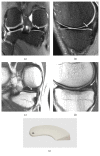
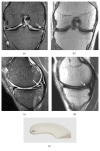


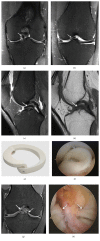

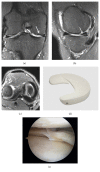





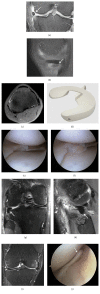

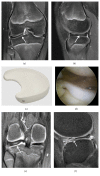
Similar articles
-
Knee MR-arthrography in assessment of meniscal and chondral lesions.Orthop Traumatol Surg Res. 2009 Feb;95(1):40-7. doi: 10.1016/j.otsr.2008.09.005. Epub 2009 Feb 4. Orthop Traumatol Surg Res. 2009. PMID: 19251236
-
Diagnosing Meniscal Pathology and Understanding How to Evaluate a Postoperative Meniscus Based on the Operative Procedure.J Knee Surg. 2018 Feb;31(2):166-183. doi: 10.1055/s-0037-1620251. Epub 2018 Jan 12. J Knee Surg. 2018. PMID: 29329471
-
Predicted probability of meniscus tears: comparing history and physical examination with MRI.Swiss Med Wkly. 2011 Dec 14;141:w13314. doi: 10.4414/smw.2011.13314. eCollection 2011. Swiss Med Wkly. 2011. PMID: 22180191
-
[Meniscal lesions].Ann Radiol (Paris). 1993;36(3):173-94. Ann Radiol (Paris). 1993. PMID: 8239451 Review. French.
-
Evaluation of acute knee pain in primary care.Ann Intern Med. 2003 Oct 7;139(7):575-88. doi: 10.7326/0003-4819-139-7-200310070-00010. Ann Intern Med. 2003. PMID: 14530229 Review.
Cited by
-
Computational technology for nasal cartilage-related clinical research and application.Int J Oral Sci. 2020 Jul 27;12(1):21. doi: 10.1038/s41368-020-00089-y. Int J Oral Sci. 2020. PMID: 32719336 Free PMC article. Review.
-
AMR Sign - An Arthroscopic S-shaped Fold Signifying Adequate Medial Meniscus Repair.Malays Orthop J. 2023 Jul;17(2):13-20. doi: 10.5704/MOJ.2307.003. Malays Orthop J. 2023. PMID: 37583526 Free PMC article.
-
Development of convolutional neural network model for diagnosing meniscus tear using magnetic resonance image.BMC Musculoskelet Disord. 2022 May 30;23(1):510. doi: 10.1186/s12891-022-05468-6. BMC Musculoskelet Disord. 2022. PMID: 35637451 Free PMC article.
-
Clinical Outcomes of Meniscus Repair with or without Multiple Intra-Articular Injections of Platelet Rich Plasma after Surgery.J Clin Med. 2021 Jun 9;10(12):2546. doi: 10.3390/jcm10122546. J Clin Med. 2021. PMID: 34207554 Free PMC article.
-
Huge intrameniscal cyst successfully treated by open debridement and combined arthroscopic and open repair: a case report.BMC Musculoskelet Disord. 2020 Mar 27;21(1):190. doi: 10.1186/s12891-020-03218-0. BMC Musculoskelet Disord. 2020. PMID: 32220248 Free PMC article.
References
Publication types
LinkOut - more resources
Full Text Sources
Other Literature Sources

